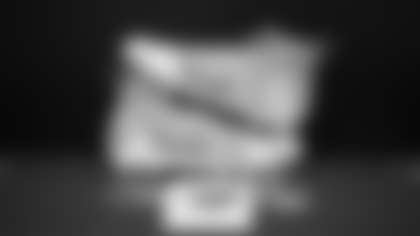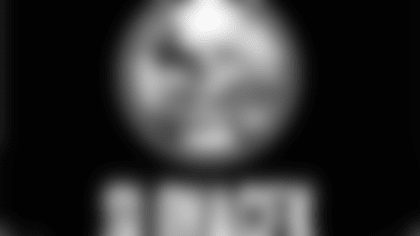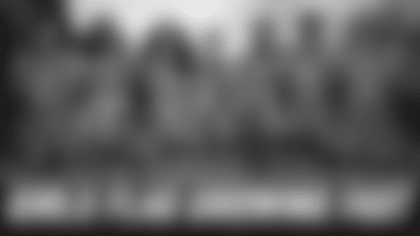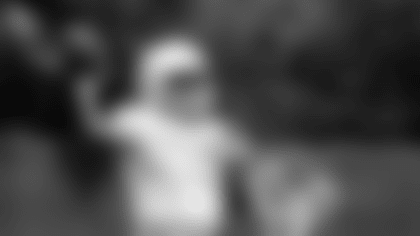Welcome to Dan Riley's first installment of Texans Fitness Corner. The initial response was overwhelming. Dan responded to seven of the questions this time around and we will continue to post selected answers to your questions throughout the year. Join in by shooting over an e-mail to fitness@houstontexans.com.
NOTE:Before engaging in any new physical activity, always consult your physician.
*
I am a college football player looking to add weight. I'm kind of a tweener between a safety and a linebacker, and I feel that with added weight I would be more productive as a linebacker. I was curious to know if you had any suggestions for added quality weight. *
>
-- Matt
Matt, thanks for your question regarding gaining weight. It's a common question and problem many young athletes have. I suggest you consult the services of a Registered Dietitian (R.D.). They are the most qualified and competent professionals in the area of nutrition.
There are three ways to gain weight: 1. Maturation, 2. Overeat and get fat, 3. Engage in a strength program and add muscle. Any weight you gain should be muscle, not fat.
You can't speed up the maturation process. Your body will be fully mature somewhere between 23 and 25 years of age. Your genetic potential will ultimately determine how much muscle you can add. You may have to accept the fact that you may not be capable of adding the amount of muscle you want.
I've trained many players with your problem. The first thing I'd suggest is to monitor your eating habits. Make sure you are eating the appropriate number of calories daily. You can't sleep in on the weekends and miss meals. Try to consume at least 25 percent of your caloric needs at breakfast. Healthy snacking between meals may be a necessity. Fruit juices (apple, grape, cranberry) are an easy method to adding calories.
Your metabolism determines how many calories you need to sustain life. The remainder of the calories you need will be determined by many additional calories you burn each day. We have a formula we use to determine how many calories you need to consume each day. This formula is a rule of thumb we use to get a ballpark figure on calories. The range is 15 to 24 calories. For players trying to lose weight we use 15. We gradually increase the number to a high of 24 for players trying to gain weight.
During the season when our players are most active I use 19 calories as a starting point. If a player weighs 200 pounds I multiply his bodyweight times 19 calories. We use 3800 calories as a starting point.
200 - bodyweight
x 19 - calories
3800 calories = daily caloric needs
We then have the player keep track of everything he eats and drinks. Using a calorie counter he adds up the number of calories he takes in each day. I've learned the eating habits of many are inconsistent and don't meet their caloric needs. Some skip breakfast, and don't take in enough fiber and vitamin D. Usually caused by not consuming enough fruit and vegetables and dairy products.
You can use this formula as a guide to your caloric consumption. You may need to adjust the number of calories you take in to generate additional gains. Maybe you need to multiply your bodyweight by 22 calories instead of 19. Remember, this formula gives you a starting point.
I strongly urge you to see a Registered Dietitian for nutrition guidance. That person will make sure your diet is balanced and will also give you tips on how to shop for foods and snacks that can help you meet your needs.
Make sure you are ingesting enough calories each day to add the muscle you are capable of adding with your strength program. Do not take in too many calories because they will be converted to fat.
The only other means you have to gain weight is by adding muscle. Other than maturation the only way to add muscle is with a strength program. It's impossible for me to give you all the information you would need to utilize our system. I do suggest the following.
>
Balance.
Equal emphasis.
Minimum amount of exercise.
Balance is essential. Some athletes spend too much time on one exercise or body part. All areas must receive equal emphasis. We divide the body into 5 major segments. They include the following:
>
Neck.
Hips & legs.
Midsection.
Torso.
Arms.
The neck is our number one priority. Once all neck exercises are performed we place equal emphasis on all muscle group. You should perform both multi-joint exercises and isolation exercises for each area of the body.
Your goal should be to find out how little exercise you need to stimulate the best gains. Most hard-working athletes perform more exercise than their body can recover from. This will prevent maximum stimulation and growth.
Remember, be reasonable on the expectations you have for your physical development. Some athletes expect more physical development than their genetic potential will allow. Best of luck and Go Texans!
**
I'm a charter Houston Texans PSL holder and I just recently tore my Achilles tendon in an industrial accident. My question to you is do you have any experience with players who have sustained such an injury playing football. What was the outcome?
- *
-- Mike
Sorry to hear about your Achilles tendon, Mike. I am not a trainer or doctor, and I am not aware of the extent of your injury. But I can tell you that during my 19 years with the Redskins, I helped several players complete their rehabilitation. In each instance the players recovered completely with no adverse affects and returned to compete at a very high level.
I'm sure it won't be long before you're out doing a good-weather dance to help expedite the work being done on our stadium. Be patient and follow the advice of your therapist. Best of luck and Go Texans!
**
What, specifically, is the absolute best way to lose extra fat and develop a strong, lean body as opposed to a bulky body?
- *
-- Carlos
Carlos, thanks for your question regarding the best way to lose extra fat. It's a great question and I'll do my best in the limited time and space we have available. There have been many books written about the topics of losing body fat.
There are three books I'd recommend. They provide a better understanding of fat. The most important issue is to not get fat. It's a book that is out of print but if you can find one I strongly suggest reading it. The title is Don't Raise Your Child to be a Fat Adult by J.F. Wilkinson. The second book is titled How to Lower Your Fat Thermostat by Dennis W. Remmington, Garth Fisher, and Edward Parent. Another book is Fat and Thin, A Natural History of Obesity by Anne Scott Beller.
Once you understand why and how you get fat, it makes it easier to understand the difficulty of losing fat. When discussing weight loss I always recommend consulting a Registered Dietitian. They are certified professionals. They have attended an accredited four-year college, passed a standardized test, completed a practicum in a clinical setting and belong to the American Dietetic Association. You can find them in the yellow pages. It is the group I rely upon for sound and reliable information.
I can tell you most diets fail unless there is some form of exercise included. I strongly endorse the Setpoint Theory. It encourages eating smaller meals and more frequently. I would strongly discourage any starvation diets. I recommend to our players that they find out "how much" they can eat and continue to lose weight, not "how little."
Once you add fat the body will resist losing it. You must accept that it is difficult to lose fat. The brain observes fat as an insurance policy. Fat is stored energy. If you don't take in enough food (energy) the body then breaks down some fat and uses it for energy.
Your genetic predisposition for storing fat, your eating habits, and your exercise habits, contribute to how much fat you have. Some people store fat easier than others and some people can burn fat more effectively than others.
Eating one meal a day or using very low calorie diets can slow your metabolism. When you return to eating more normally you gain the weight you lost and then some, even when you eat less than you did before. The Setpoint Theory attributes this additional gain in fat to your metabolism being slowed down by the brain. By eating smaller and more frequent meals you can speed up your metabolism. You can also speed up your metabolism with aerobic exercise.
Remember, it's not just the calories you burn while exercising that count, it's also how many more calories can you burn during the non-exercising hours of the day.
It is difficult to determine exactly how many calories are needed to maintain bodyweight, and even more difficult to lose weight. A formula we use as a general guideline is the following:
Body weight x 15 = calories to maintain bodyweight.
To lose one pound of fat per week subtract 500 calories from the above.
Example: Let's assume you weigh 200 pounds. Multiply 200 pounds x 15 = 3000 calories. Subtract 500 calories from 3000 calories = 2500 calories. One pound of fat equals 3500 calories. At the end of the week you should lose approximately one pound of fat.
200 lbs. = Body weight
x 15 = Calories
3000 = Calories needed to maintain weight. .
-500 = Deduct 500 calories.
2500 = Number of calories consumed/day for one week to lose one pound of fat.
We have a few guidelines we give our players regarding weight loss.
· Eat breakfast seven days a week.
· Plan four to six smaller meals/day, instead of one big meal.
· Monitor the number of calories you consume.
· Consume 60% of your calories in the form of carbohydrates.
· Only 25% of your calories come from fat.
· Protein should make up 15% of your calories.
· Eat from all food groups.
· Eat five servings and one serving of fruit daily.
· Drink at least 64 ounces of water/day.
· Walk three miles daily.
Consult a Registered Dietitian for specific menus, and remember to be patient. Your goal should be to lose no more than 1 - 2 pounds per week. Best of luck with your program and Go Texans!
*
I'm trying to join the police department. I have passed all the physical tests except the bench press. What can I do to help my bench press? *
>
-- Matt
Thanks for your question regarding how to improve your bench press, Matt. All of the muscles crossing the shoulder and elbow joint contribute to the execution of the bench press. The chest, frontal shoulder, and triceps are the prime movers. The bench press is a multi-joint movement (elbow, shoulder, wrist). It involves several muscles.
I'd suggest you continue performing the bench press using the technique and combination of sets and reps you have been using. You have probably gained as much strength as you can from just performing the bench press. I would recommend performing an isolation movement for each of the muscles that contribute to the bench press.
By isolating the chest, the shoulders, and the triceps, you will strengthen each of these muscles to their maximum. It may be enough to generate an increase in strength when these muscles work together when performing the bench press. If possible find equipment that isolates the chest (some type of pec dec), shoulders (lateral raise, front raise), and any isolation movement for the triceps.
If you haven't been performing these exercises you may have to decrease the amount of exercise you have been performing. Additional exercise may prevent you from recovering from your existing workout. If ever in doubt perform less exercise. More often than not people perform too much exercise, preventing complete recovery.
Negative only dips are another option. It is a great exercise if properly performed. You can lower more weight than you can raise. With conventional exercise you are limited to how much weight you can lower, by the amount of weight you use to lift the weight. Ideally you would lift a given weight and have people slip on additional weight during the lowering phase and then take the additional weight when the weight was lifted.
This protocol isn't practical. Therefore, we suggest performing negative only exercise. Be cautious because you are able to handle significantly heavier weights, which may be enough to enhance your bench press. The muscles used to perform a dip are the same muscles used to bench press. I don't recommend performing the bench press in a negative only manner because skillful spotters are essential.
To execute a negative only dip you will only lower your body. Allow eight seconds from the beginning (arms extended position) to the end (arms bent position) of each repetition. The lowering speed should be smooth, consistent and controlled. Dip bars with steps to walk up are needed to recover to the starting position. A stool or bench can be used to step up on.
Use caution when stepping off the step or stool. Step off one leg at a time and bend the legs to prevent swinging back and forth. We use a stopwatch and sound off with an eight second cadence. Our players perform eight reps (a total of 64 seconds of exercise). Do not allow time to recover between reps. Recover to the starting position immediately.
Start with your body weight. When you can complete eight perfect reps begin adding weight with a weight belt. Use 10-pound increments. When you can complete eight good reps with a 10-pound plate, go to 20 pounds the next workout. Continue this process until you are satisfied with the results.
Use strict form and use the full eight seconds each rep. Many people become preoccupied with how much weight they use and cheat. This is a very demanding exercise if performed properly.
I strongly recommend you keep a watchful eye on the amount of exercise you perform. I wouldn't recommend negative dips more than twice a week. If you feel you aren't recovering cut back on the amount of work you are doing. Best of luck and go Texans!
**
I'm a 65-year-old female in excellent health. My question is how can I be sure I don't have "flag-waving" arms? I use two five-pound weights to try to build my upper-body strength, but what is a good way to work the triceps - the culprit in flabby arms? I find this to be the hardest muscle to exercise.
- -- Nancy
Nancy, congratulations on your interest and participation in strength training. Senior citizens have more to gain from strength building activities than any segment of our society. The aging process gradually erodes the muscles we were blessed with in our youth. After the age of 30, the average male loses ½ to 1 pound of muscle a year (unless strength building exercises are performed).
Many adults replace this loss in muscle with fat. In my opinion, properly performed strength training exercises will benefit the quality of life better than any other form of exercise. You mentioned that you use 2-5 pound weights to build your upper body strength. You asked what was a good way to work the triceps (you stated "the culprit in flabby arms."). You also had some concern about becoming too muscular.
It is difficult for me to provide this type of information without a visual. If it's possible I'd recommend you find a well-equipped facility and meet with a certified personal trainer that has experience working with seniors.
If this isn't possible I'll try and give you some information that may be of some value to you. Don't worry about getting "too big." Visit a gym and take a look around. Your age and gender will prohibit significant changes. It should be your goal to generate any gains possible in the safest manner possible. It will increase your energy level and promote firming and toning your muscular system.
You mentioned you use two to five-pound weights. These weights may be productive for some exercises and ineffective (too light) for others. To stimulate a change in muscular fitness a muscle needs overload (more weight and/or more reps, or more time to complete an exercise). If you are satisfied with the results you are getting continue using the same weights and you'll stay the same. If you want better results you will have to increase the resistance.
I'd also recommend you try some form of Super Slow reps. There are many variations to how slow reps can be performed. I use slow reps almost exclusively in the early phases of rehabilitation and for variety for our players. When performing a slow rep we take eight seconds to raise the weight. We use a stopwatch to determine the raising speed. Spread the eight seconds out from the beginning to the end of each rep. We perform eight repetitions. The weight is lowered in a smooth and controlled manner.
Slow reps are safe, joint friendly and very productive. You will also need less weight. You should try using slow reps for variety.
You wanted an exercise to develop the triceps (the muscle on the back of the upper arm). The triceps assist the muscles of the chest and shoulders any time you perform a pushing movement (pushup, dips, bench press, etc.). To isolate the triceps you must keep the upper arm stationary and move only the forearm. There are two triceps extension exercises you can perform at home with your hand weights.
Starting Position: Sitting in a chair with your back supported, right arm extended overhead while holding the hand weight, with the palm facing inward, with the left hand used to hold the right upper arm stationary.
Execution: Bend the right arm moving only the lower arm, to a fully bent position and pause momentarily before recovering to the starting position. Eliminate any sudden or jerky movements. Perform 12 repetitions. When you are capable of completing 12 reps add more resistance. Continue this process until you are not willing to work any harder or you are satisfied with the results. Mirror the above protocol using your left arm. Another isolation exercise for the triceps is a lying triceps extension.
Starting Position: Lying on the floor with your right arm extended (perpendicular to the floor), with the palm facing inward, while holding your hand weight, with the left hand supporting the back of the right arm.
Execution:Same as above for the seated triceps extension.
I hope this information will be of some value to you. Keep up the good work and spread the word about strength training for seniors. Best of luck and Go Texans!
*
In general, what type of aerobic conditioning do you promote for NFL football players? *
>
-- Frankie
Frankie, there are three major energy systems used by the body. They are the ATP-PC System, the Lactic Acid System, and the Aerobic System. The first two are anaerobic. These are the dominant systems used to provide the energy to play the game of football. These are the two systems we spend the most time developing.* *We emphasize the aerobic system early in our off-season, during rehabilitation and to promote weight loss. We utilize the same standards used to train aerobically by non-athletes. Duration, frequency, and intensity, are the variables. Early in the off-season we use 20 to 30 minute programs, 3 times a week, at approximately 70 to 85% of maximum heart rate.
Our treadmills are programmed with a variety of walking and running protocols. Many of our bigger linemen use the walking protocols. If a player has a joint problem we put them on a stationary bike. Best of luck and Go Texans!
Can you tell me the best way to gain size on arms and chest?
>
-- Dustin
Dustin, I truly believe if you only target these areas you will never reach your full physical potential. I would recommend that you place equal emphasis on every major muscle group in your body.
Your genetic potential will ultimately determine just how much size and strength you can gain. There are certain physical attributes that you must possess to generate significant gains. If you have been training and reached a plateau, I would suggest cutting back on the amount of exercise each workout and possibly decrease the number of workouts each week.
The quality of the exercise you perform is a big factor in generating maximum gains. Many people want maximum gains but aren't willing to work at a level needed to develop maximum gains.
The equipment you have available determines which exercises you can perform. We recommend variety. We substitute various pieces of equipment to perform the same exercise. Our rep range is between 6 and 12 reps.
A technique you might try is a method called "pre-exhaustion." With this technique you isolate a muscle with one exercise followed immediately by a multi-joint movement. For example perform a hard set of 10 reps on a pec dec or flys with dumbbells followed immediately with a hard set of dips or an incline press.
You can use the same technique with your arms. Isolate your triceps with a hard set of triceps extension followed immediately with a set of dips or close grip bench. For your biceps perform a hard set of curls followed immediately with a set of chin-ups or close grip lat pulldowns (with an underhand grip). Best of luck with your training and Go Texans!













